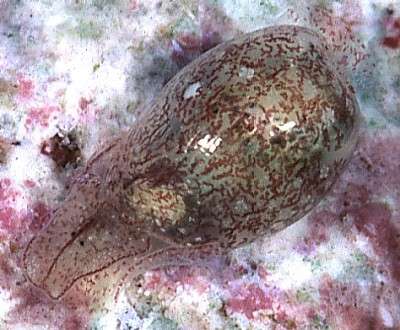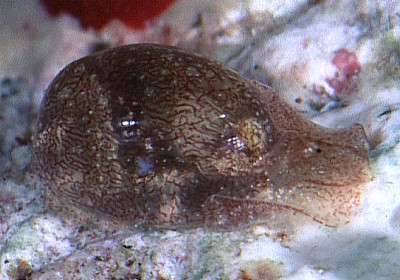Another bubble shell from Kerama Island
February 3, 2000
From: Atsushi Ono


Dear Bill,
Here is another CEPHALASPIDEA species from Kerama Is, near Okinawa, Japan. 4m depth. It was on a rope covered with algae and sponge.
Both photos are of the same individual, shell length 6mm. I have seen several individuals of this species here.
Is this an Atys or Haminoea species?
Could you help me to identify these species?
Sincerely,
Atsushi Ono
ononini@cosmos.ne.j
Ono, A., 2000 (Feb 3) Another bubble shell from Kerama Island. [Message in] Sea Slug Forum. Australian Museum, Sydney. Available from http://www.seaslugforum.net/find/1822Dear Atsushi,
I am sorry again to be unable to help you with a name for this animal. From the shape of the body and shell it is possibly a species of Haminoea.
We have a major problem in identifying cephalaspids (bubble-shells) because in earlier times many species were described and named from the empty shell alone and so we don't know what the animal looks like. Another problem is that often two or more species can have almost identically shaped shells. Sometimes even species from quite different families can have identically shaped shells. Therefore in case of some named species the shells have been placed in the wrong genus or even family.
So when we now find a living animal we need to remove its shell and try and find a named shell that matches it, even if it is clearly in the wronf family. If we find two or three named shells which match it in shape, what do we do? Clay Carlson has for many years been investigating cephalaspid animals and trying to identify them with named shells. It is a very slow and exhausting task.
Many early European and American explorers took specimens from Japan, Australia, and much of the tropical world, and deposited them in museums in Europe and America. Often the published descriptions of these specimens were poor, with no illustrations or very inadequate illustrations. The only way to resolve many of these puzzles is to visit museums throughout Europe in the hope of finding the right shell. It is extremely expensive and often frustrating, but necessary for malacologists from outside Europe to travel around European museums trying to find these specimens so they can make sense of their local faunas. However, it is very hard to convince governments that it is important to fund trips to Europe to look for lost shells which you don't even know exist.
In Japan there have been a number of very productive workers who have studied cephalaspids and published detailed descriptions of their shells. However you would need to look at the shells of your animals before a comparison could be made.
Bill Rudman.
Related messages
-
Re: Haminoeid sp. 2 from Heron Island
From: Clay Carlson & Patty Jo Hoff, April 25, 2005 -
Haminoeid sp. 2 from Heron Island
From: Julie Marshall, April 23, 2005 -
Re: unidentified cephalaspid from Kerama Is
From: C.Carlson & P.J.Hoff, February 18, 2000
